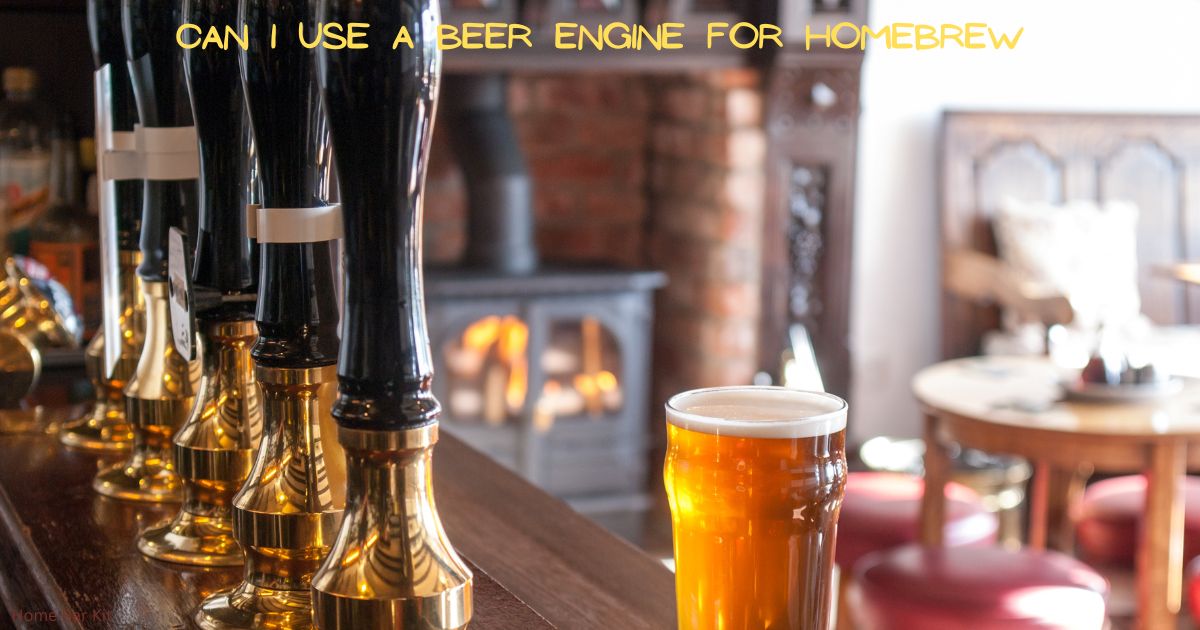Most homebrewers will use either bottles or a pressure barrel for their beer. Each have their advantages and disadvantages. However some like to use a beer engine for their homebrew. But is this possible?
It is possible to use a beer engine for serving homebrew. However it needs to be connected to either a cask using the appropriate beer lines and connectors. Or it can be connected to a polypin bag, again using the right connectors and beer line.
Get the set up right and you can serve your homebrew just like they serve beer in a pub.
Table Of Contents
Using A Beer Engine For Homebrew
Using a beer engine for homebrew is ideal, especially if you have a home bar or pub shed. They are used for low carbonated beers like bitter and real ales.
With the beer engine fixed to the bar top, the beer whether in cask or polypin can be set up under the bar and connected to the beer engine.
Ideally the beer should be set up in a fridge to keep it cool or run through a cooler unit.
The reason some people use a polypin is because as the beer is drawn the bag collapses so no oxygen enters it. This means the beer lasts longer.
Other people use a corny style keg and low pressure C02 to keep the beer fresher for longer.
What Equipment Do I Need To Set Up A Beer Engine Draught System?
The main bit of kit needed is obviously a beer engine. A new beer engine from somewhere like Pint 365 will cost you around two hundred pounds.
However you can find second hand ones on the internet on places like Ebay. With a secondhand beer engine you may have to recondition it or at least do some clean up work.
Beer Engine To Polypin
There is not much needed for connection to a polypin. Just a food grade pipe with the right connections to fit to the back of the beer engine and the polypin tap.
Then you are good to go, just draw the beer through the beer engine.
It is also very easy to disconnect the beer line from the polypin when not in use.
The parts needed can all be sourced online from beer supply companies. Or if you opt for a Pint 365 beer engine they come with the pipe and connectors included.
Beer Engine To Keg
Connecting a beer engine to a keg is a little more involved and will also involve more parts to set it up.
You will still need a length of food grade pipe cut to the required length. Then you will need a check/demand valve which goes between the beer pump and the keg. It is fitted in the line close to the beer pump.
The check/demand valve is important because the use of C02 at the keg. If a check/demand valve is not fitted then the beer will be forced through the beer engine even without pulling the handle.
Again you will need the right connectors to fit the line to the keg. And the keg will need to be set up with C02 which should be set low so as not to over carbonate the beer.
Again the beer line and connectors can be sourced online from home brew shops and the like.
What Is A Beer Engine?
A beer engine or beer pump is simply a pump that operates through a pull handle. When the handle is pulled the pump draws the beer from its cask through the pipe and into the engine.
Once the system is primed then beer will be dispensed through the spout every time the handle is pulled. A beer pump will dispense either a quarter of a pint with each pull. Or a half a pint on each pull depending on the model.
The beer pump is the traditional way that real ales and bitters are poured in pubs and bars across the UK.
However there is no reason why they can’t be set up at home, as long as they are set up in the right way.
Final Thoughts
If you fancy the pub beer taste at home, then consider setting up your own beer pump. They can be used for homebrew as well as beer in a bag purchased from your local brewery.
And they certainly enhance any home bar or pub shed. This is one of my next projects in my pub shed. I am not sure whether I will go down the polypin route or the keg route.
I will write about it when I set it up. Mine will also feature a fridge that will be converted into a fermentation unit. So I will use the fermentation unit to control the temperature of my homebrew. Then use it to keep the beer at my required temperature once it is hooked up to the beer pump.
If you have any questions the do share them below. Also share your thoughts if you have your own beer engine and how your set up works.
Rob is a passionate home bar and pub shed enthusiast with a passion for craft beer. With hands-on experience in designing and building his own home bar, Rob shares his knowledge, tips, and inspiration to help fellow enthusiasts create their own perfect space. Alongside the world of home bars and pub sheds, Rob also explores the diverse and exciting realm of craft beer, providing honest reviews to help you discover your next favorite brew. Join Rob on a journey of flavor, design, and craftsmanship right here on Home Bar Kit.

